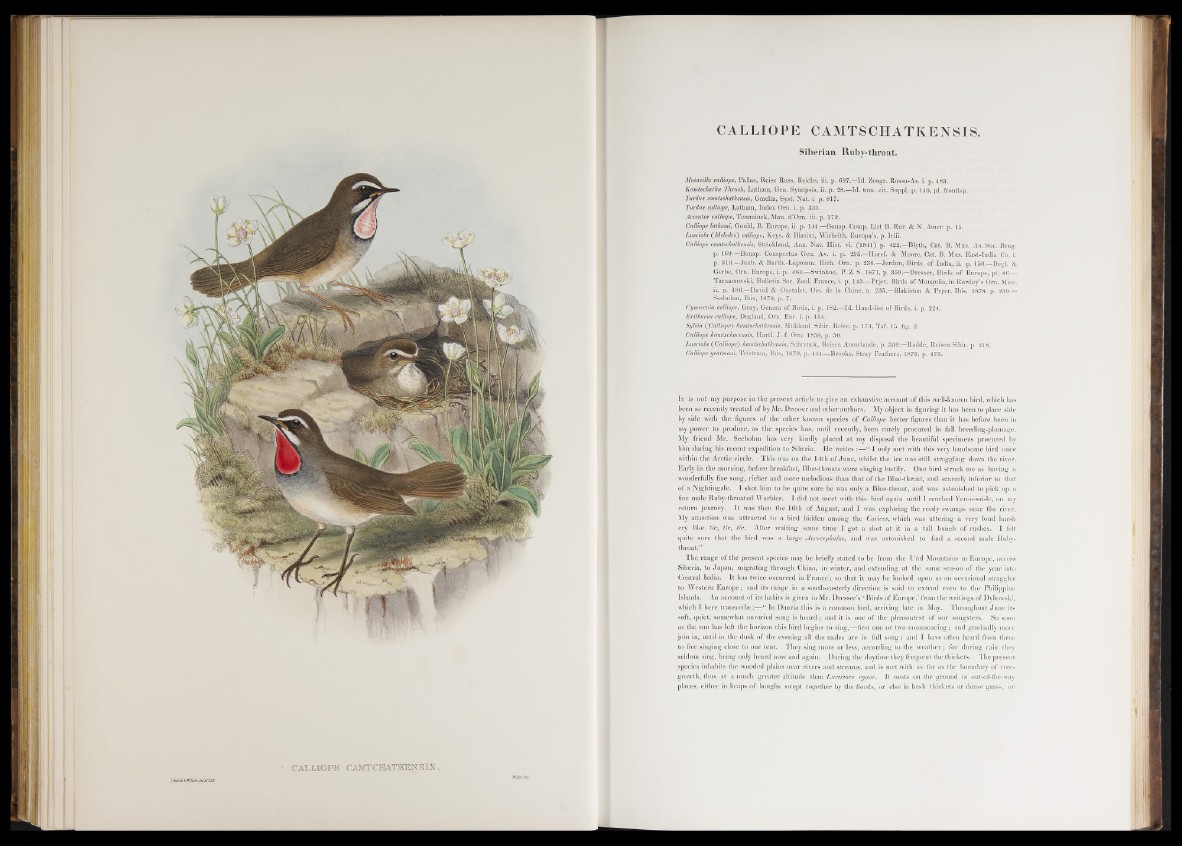
CALLIOPE CAMTCHATKENSIS.
CALLIOPE CAMTSCHATKENSIS.
Siberian Ruby-throat.
Motacilla calliope, Pallas, Reise Russ. Reichs, Hi. p. 697.—Id. Zoogr. Rosso-As. i. p. 483.
Kamtschatka Thrush, Latham, Gen. Synopsis, ii, p. 28 — Id. tom. pit. Suppl. p. 140, pi. frontisp.
Turdus camtschatkensis, Gmelin, Syst. Nat. i. p. 817.
Turdus calliope, Latham, Index Orn. i. p. 33l£*-;> .
Accentor calliope, Temminck, Man. d’Orn. iii. p. 172.
Calliope lathami, Gould, B. Europe, ii. p. 144.—Bonap. Comp. List B. Eur. & N. Amer. p. 15.
Lusciola (Melodes) calliope, Keys. & Blasius, "Wirbelth. Europa’s, p. lviii.
Calliope camtschatkensis, Strickland, Ann. Nat. Hist. vi. (1841) p. 422.—Blyth, Cat. B. Mus. As. Soc. Beng.
p. 169.—Bonap. Conspectus Gen. Av. i. p. 295.—Horsf. & Moore, Cat. B. Mus. East-India Co. i.
p. 313.—Jaub. & Barth.-Lapomm. Rich. Orn. p. 236.—Jerdon, Birds of India, ii. p. 150.—Degl. &
Gerbe, Orn. Europe, i. p. 464.—Swinhoe, P. Z. S. 1871, p. 359.—Dresser, Birds of Europe, pt. 46.—
Taczanowski, Bulletin Soc. Zool. France, f. p. 143.—Prjev. Birds of Mongolia, in Rowley’s Orn. Misc.
ii. p. 180.—David & Oustalet, Öis. de la Chine, p. 235.—Blakiston & Pryer, Ibis, 1878, p. 239.—
Seebohm, Ibis, 1879, p. 7.
Cyanecula calliope, Gray, Genera of Birds, i. p. 182.—Id. Hand-list of Birds, i. p. 224.
Erithacus calliope, Degland, Orn. Eur. i. p. 154.
Sylvia ( Calliope) kamtschatkensis, Middend. Sibir. Reise, p. 174, Taf. 15. fig. 2.
Calliope kamtschacensis, Hartl. J. f. Orn. 1859, p. 50.
Lusciola (Calliope') kamtschatkensis, Schrenck, Reisen Amurlande, p. 359.—Radde, Reisen Sibir. p. 248.
Calliope yeatmani, Tristram, Ibis, 1870, p. 444.—Brooks, Stray Feathers, 1879, p. 475.
It is not my purpose in the present article to give an exhaustive account of this well-known bird, which has
been so recently treated of by Mr. Dresser and other authors. My object in figuring it has been to place side
by side with the figures of the other known species o f Calliope better figures than it has before been in
my power to produce, as the species has, until recently, been rarely procured in full breeding-pluinage.
My frieud Mr. Seebohm has very kindly placed at my disposal the beautiful specimens procured by
him during his recent expedition to Siberia. He writes :— “ I only met with this very handsome bird once
within the Arctic circle. This was on the 14th of June, whilst the ice was still straggling down the river.
Early in the morning, before breakfast, Blue-throats were singing lustily. One bird struck me as having a
wonderfully fine song, richer and more melodious than that o f the Blue-throat, and scarcely inferior to that
of a Nightingale. I shot him to be quite sure he was only a Blue-throat, and was astonished to pick up a
fine male Ruby-throated Warbler. I did not meet with this bird again until I reached Yen-e-saisk', on my
return journey. It was then the 16th o f August, and I was exploring the reedy swamps near the river.
My attention was attracted to a bird hidden among the Carices, which was uttering a very loud harsh
cry like tic, tic, tic. After waiting some time I got a shot a t it in a tall bunch of rushes. I felt
quite sure that the bird was a large Acrocephalus, and was astonished to find a second male Ruby-
throat.”
The range of the present species may be briefly stated to be from the Ural Mountains in Europe, across
Siberia, to Japan, migrating through China, in winter, and extending at the same season o f the year into
Central India. It has twice occurred in F ran ce; so that it may be looked upon as an occasional straggler
to Western Europe; and its range in a south-easterly direction is said to extend even to the Philippine
Islands. An account of its habits is given in M r. Dresser’s ‘ Birds of Europe,’ from the writings of Dybowski,
which I here transcribed^-“ In Dauria this is a common bird, arriving late in May. Throughout June its
soft, quiet, somewhat unvaried song is heard ; and it is one of the pleasantest of our songsters. So soon
as the sun has left the horizon this bird begins to sing,—first one or two commencing; and gradually more
join in, until in the dusk of the evening all the males are in full song; and I have often heard from three
to five singing close to our tent. They sing more or less, according to the weather ; for during rain they
seldom sing, being only heard now and again. During the daytime they frequent the thickets. The present
species inhabits the wooded plains near rivers and streams, and is met with as far as the boundary of tree-
growth, thus at a much greater altitude than Laroivora cyane. I t nests on the ground in out-of-the-way
places, either in heaps of boughs swept together by the floods, or else in bush thickets or dense grass, or